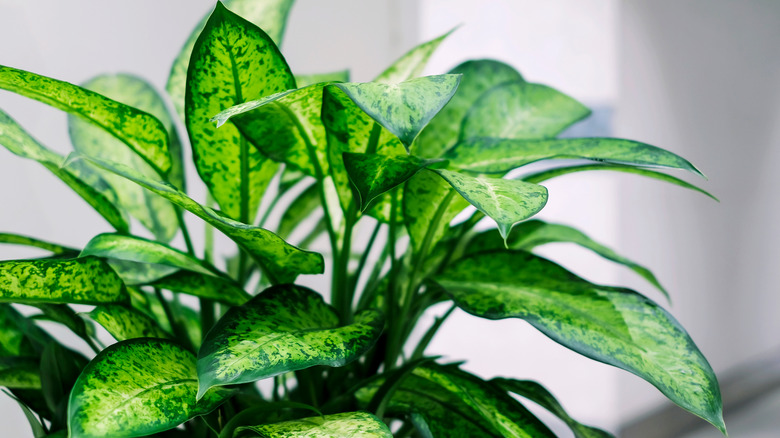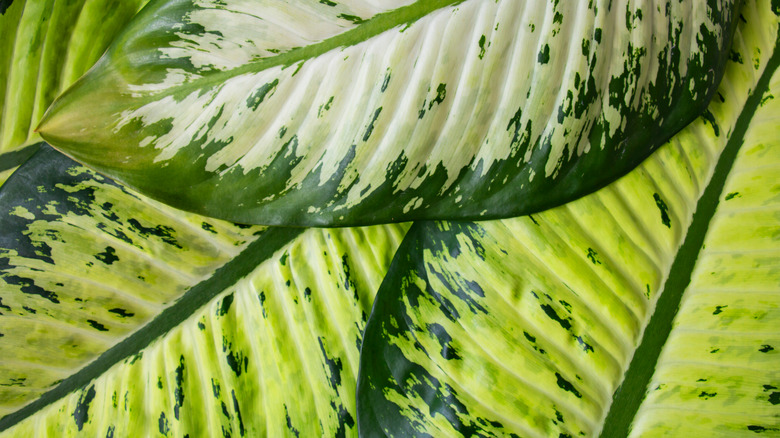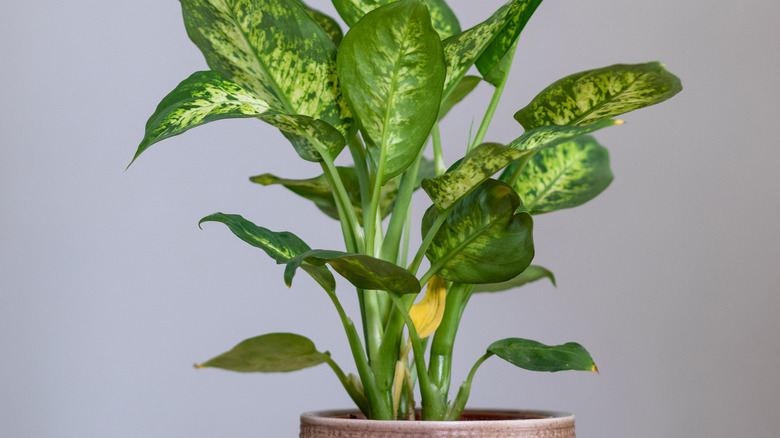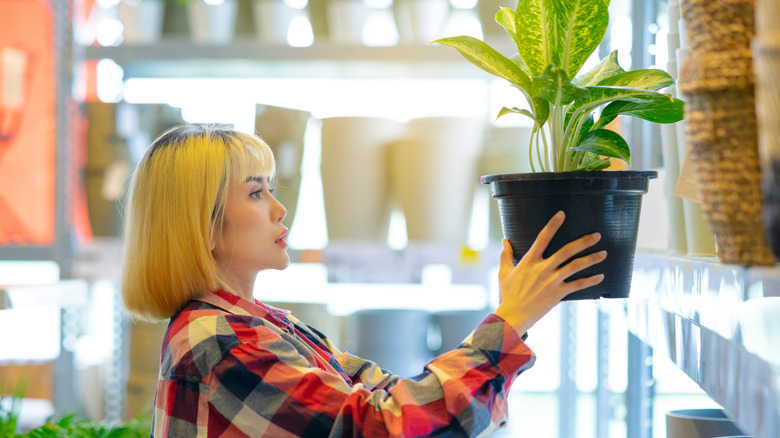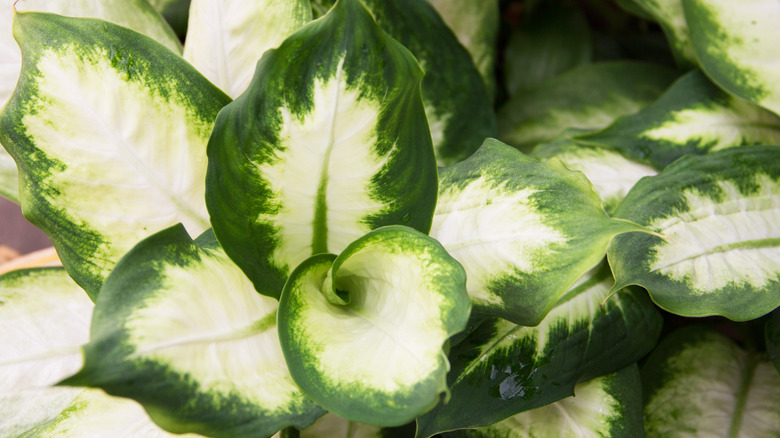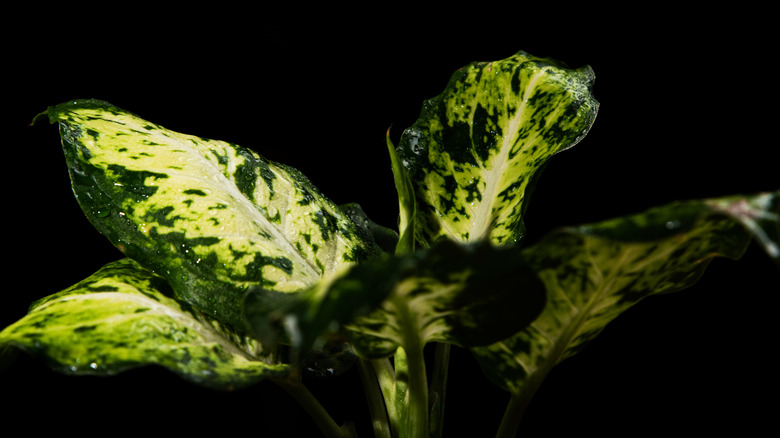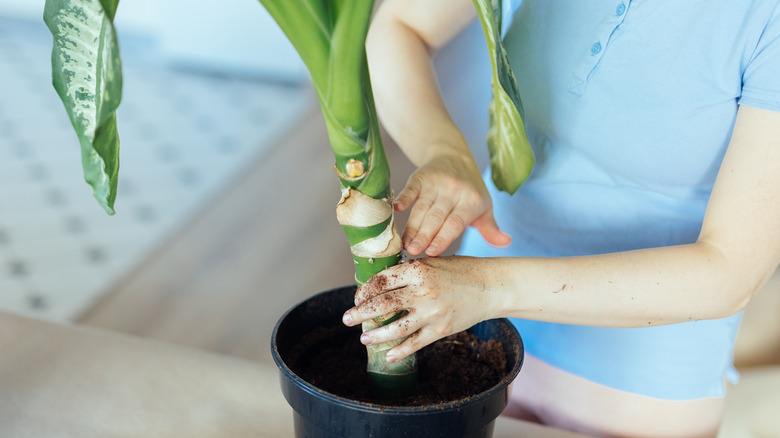How To Grow And Take Care Of A Dumb Cane Plant
The dumb cane plant, also known as mother-in-law's tongue, leopard lily, and by its scientific name, dieffenbachia, is a popular house plant thanks to its hardy reputation and striking looks. As its feline nickname suggests, this plant is instantly recognizable thanks to the irregular spots of pale green or yellow color that radiate from the center of each dark green leaf. The leaves, which can grow up to 20 inches long and 10 inches wide, sprout from a thick central stalk. Overall, the plant can grow up to six feet tall. Though the plant can flower and produce bunches of red-orange berries, it's extremely rare as conditions must be perfect, per House Plants Expert.
The dumb cane plant is native to tropical America and the West Indies, according to Brittanica, though now it can be found in plant stores all over the world. The plant earns its name from the short-term muteness that can occur if part of the plant is ingested. The sap causes inflammation in the tongue and throat, making it impossible to speak for up to two weeks. Additionally, the sap is known to cause skin irritation, and you should always wash your hands after handling this plant. Though it may seem like a less than ideal house plant candidate, the easy-to-grow nature and commanding presence of the dumb cane plant make it a worthwhile addition. Plus, any challenges the plant presents are easily overcome.
How to Use Dumb Cane in Garden
With its large leaves and impressive height, the dumb cane plant can easily become the focal point in your garden, though it does best in indirect sunlight and can even flourish in complete shade, according to Get Busy Gardening. That being said, this plant is especially well suited to shade gardens, a type of garden composed of low-light loving plants.
To incorporate this tropical plant into your garden, consider taking advantage of its height and using the plant as a border to help frame smaller plants. You may also consider using it as the star player and layering shorter, more shrub-like plants around it. Because this is a tropical plant, it is best suited to climates that are warm year-round. If you live somewhere that experiences cold weather; you can still have dumb cane in your garden -– simply plant it in a pot. That way, you're able to not only rearrange your garden as you please, but you can also enjoy the beauty of the plant indoors during colder months.
How to Grow Dumb Cane
Luckily for plant lovers, dumb cane practically grows itself. The best way to grow one begins with an already established plant like that which you would get from a gardening center or through stem cuttings, also known as propagation. If propagating an already existing plant, cut off the very top of the plant, leaving the topmost two leaves, per Garden Lovers Club. Then, place the cutting in moist potting soil. Once roots start to appear, you can plant the cutting in a container.
When planting dumb cane in a pot, be sure the container is no more than ⅓ larger in diameter than its original container. Dumb cane thrives in well-drained soil, which can be achieved by adding sand, small rocks, or pearlite to the soil. Place your plant in its new container; the root ball should sit about one inch below the lip of the container. Then, add potting soil all the way to the top of the container, making sure the roots are completely covered.
If you are planting your dumb cane outdoors, the same principles apply. Make sure the hole is large and deep enough to accommodate the root ball and that the soil drains well. Be sure to give your newly planted dumb cane plant a healthy drink of water as it prefers its soil moist at all times.
How to Care for Dumb Cane
Unlike other house plants, dumb cane plants can thrive in a variety of circumstances. Though they prefer bright, indirect, and filtered natural light, such as the light through a sheer window curtain, they do well in partial shade too. They can't tolerate intense direct sunlight as that will cause their leaves to become scorched, according to Gardening Know How. No matter where you place your plant, make sure you are rotating it regularly to promote even growth.
Since dumb cane plants are native to tropical climates, it's important to keep their soil moist but not wet. To make sure the plant isn't overwatered, check and make sure the top inch of soil is dry before watering it. Additionally, consider running a humidifier in close proximity to your dumb cane plant to emulate its original tropical environment. Spritzing it daily with a plant mister is a great way to produce humidity, too.
Varieties of Dumb Cane
With 24 different varieties, this plant is sure to have a variation that speaks to your taste in houseplants. Though the leaves generally all follow the lighter center, darker edge formula, here are a few notable varieties, per Balcony Garden Web.
-
Camille: This variation of dieffenbachia boasts a stark, almost-white blaze down the center of each lime-colored leaf, making it an instant stand-out.
-
Tropical Tiki: With emerald-toned leaves and a wash of light green punctuated by pale yellow speckles, this variety certainly evokes feelings of a tropical location.
-
Delilah: One of the more unique dumb cane plants, this variety features long tapered medium-green leaves with a brushstroke of pea-green down the center. A spray of pale yellow dots covers each leaf.
-
Mary: Like the 'Camille' variety, this version leans on the lighter end of the color spectrum. With large swaths of lemon-lime covering the majority of each kelly-green leaf, this plant is especially well suited to brighten up dark spaces.
-
Star Bright: Most notable for its more narrow, golden-green leaves, this variety features a mottling of forest green, pale yellow, and bright white "stars" across each leaf.
Is Dumbcane Toxic?
As mentioned before, the dumb cane plant is most certainly toxic. According to the ASPCA, pets who chew on the leaves will experience oral irritation, excessive drooling, and vomiting. Though rarely fatal, its muteness-inducing sap should never be ingested. That being said, it's best to forego this plant if you live in a home where the brightly patterned leaves may be tempting to dogs, cats, and kids alike. Additionally, it's best to always handle these plants while wearing gloves and to wash your hands afterward.
Though there are records of indigenous people in central and south America using the sap from the dumb cane plant to treat snakebites, rheumatism, and gout, there are many more records of the toxic nature of the plant being utilized on poison arrowheads and as punishment, according to University of Oxford. If you accidentally get the sap on, in, or near your mouth, The Gardening Cook recommends drinking milk to ease symptoms and seeking medical attention if symptoms do not subside within a few days.
How to Re-pot Dumb Cane
If your dieffenbachia has grown too big for its current container, re-potting it is your best bet to ensuring the plant stays healthy. Be sure to wear protective gloves when handling the plant. SFGate recommends moving up one container size when re-potting your plant. It's best to choose a container with drainage holes to help prevent root rot caused by overwatering.
When you take your plant out of its current container, be sure to examine its roots. If the roots are tangled up in the shape of the container, gently loosen them with your fingers. Next, fill your new container up about 75% of the way with well-draining potting soil. Then, add your plant and continue adding more soil until the root system is completely covered. Make sure your plant is secure in its new pot by tapping down the soil around its base. Lastly, give it a good drink of water until it seeps out of the draining holes.
